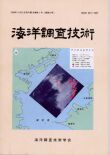All issues

Volume 10 (1998)
- Issue 2 Pages 2_1-
- Issue 1 Pages 1_1-
Volume 10, Issue 1
Displaying 1-4 of 4 articles from this issue
- |<
- <
- 1
- >
- >|
Articles
-
Akira Wada, Hisashi Fukano, Tairyu Takano, Yuji Ishikawa1998Volume 10Issue 1 Pages 1_1-1_24
Published: 1998
Released on J-STAGE: October 30, 2012
JOURNAL FREE ACCESSThe objective of this research is to develop a method whereby the future of water quality leading to eutrophycation, origo-oxygen phenomena, etc. in the closed sea areas can be forecast and evaluated at a certain level. For this purpose, the environmental characteristics of the sea areas are researched from physical, chemical and biological aspects, and the condition of these characteristics is synthetically reproduced by means of the water quality model.
In this prediction and analysis of water quality, an attempt was made to predict the quality of water in Tokyo Bay on the basis of the flow field determined using the newly developed box model.
Comparison was made between calculations reproducing the present condition of the water quality in summer and measured values. As a result, we consider it basically possible to reproduce many items and to examine the effect of water quality in a diversified manner.View full abstractDownload PDF (3727K) -
Hiromi Fujimoto, Atsushi Oshida, Toshio Furuta, Toshihiko Kanazawa1998Volume 10Issue 1 Pages 1_25-1_38
Published: 1998
Released on J-STAGE: October 30, 2012
JOURNAL FREE ACCESSAn ocean bottom gravimeter system was newly developed to carry out seafloor gravimetry in the same way as on land. The objectives are 1) development of gravity bench marks on the seafloor to monitor deformation of the seafloor and 2) dense seafloor gravimetry to obtain fine density structure beneath the seafloor. The gravimeter adopts a Scintrex CG-3M/SB gravimeter suspended by gimbals to keep the sensor vertical. The other components are tilt meters, a depth sensor, a data logger/controller, and a set of Ni-Cd battery cells. These are set into 2 pressure spheres, one made of titanium alloy and the other made of glass so that the system can be used up to 6,500 m in depth. Trial experiments at shallow sea floor have shown the performance as was expected.View full abstractDownload PDF (1847K) -
Kentaro Narigasawa, Yoshihiro Sonoda, Kouji Satoh1998Volume 10Issue 1 Pages 1_39-1_48
Published: 1998
Released on J-STAGE: October 30, 2012
JOURNAL FREE ACCESSRemote sensing is an effective means to monitor oil discharge from oil tankers. This paper discusses the evaluation of remote sensing data of oil discharge from an oil tanker in Tokyo Bay on July 2, 1997 collected by air borne and satellite sensors.
Air borne remote sensing data of oil spill were collected from July 2, to July 5, under clear skies. Both color aerial photographs and thermal IR images were taken 6 hours and 20 minutes after the out break of oil discharge. This series of data captured the entire oil spill from the oil tanker. By using this data, thickness of oil spill was classified and the volume of discharged oil was estimated.
The results are as follows:
(1) Air borne remote sensing data were collected 6 hours and 20 minutes after the out break of oil discharge. The total volume of the discharge was 1,556 kl. Analysis of color photographs and thermal IR images could detect the dimension of the oil spill.
(2) By using color aerial photographs and thermal IR images, oil slick was classified into three thickness levels. Volume of oil of each thickness class was calculated.
(3) Thermal IR data could detect the thick oil area and this indicated that the thermal IR data is useful for the planning of oil recovery and chemical treatment.View full abstractDownload PDF (3339K) -
Yoshitaka Morikawa, Takashi Koike, Youhei Mizutani, Yutaka Nagata1998Volume 10Issue 1 Pages 1_49-1_56
Published: 1998
Released on J-STAGE: October 30, 2012
JOURNAL FREE ACCESSIn order to trace a movement of a spiny lobster in an experimental tank under dark condition, a two-dimensional tracking device was designed, and its outline was reported in the previous paper(Koike et al., 1996). We found a defect that water level change of several mm produce error of about 10 cm in lobster position in this device. To minimize this error, the lobster cage is completely submerged except its supporting poles. However, we need to set a ceiling net and a slippery wall to the lobster cage. These increases drug force of the cage, and results swing of the cage due to flow inside the tank. The end shape of the water supply pipe was reformed so as that the flow in the tank is slow and smooth enough to avoid significant error in determination of lobster position.View full abstractDownload PDF (956K)
- |<
- <
- 1
- >
- >|